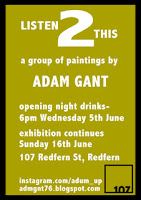Cyclical histories- paintings of Lubaina Himid
Lubaina Himid was born in 1954 in Zanzibar, after arriving in England in the 1960's she has studied Theater Design and Cultural History, and is a Professor of Contemporary Art at the University of Central Lancashire.
She has been exhibiting her paintings since the 1980's when she was involved in curating 3 exhibitions across London between 1983 and 1985 that challenged the invisibility of Black and Asian women in the art world, these shows engaged with the political, social, cultural and aesthetic themes that defined this time.
In Himid's work the celebration of Black creativity and the influence of African culture in England and around the world is central, while it critiques the institutional negligence of doing little to include or promote work from other cultures.
The groups of artists that exhibited with Himid in the early 80's were making issue based art at a time when the perceived injustice of the police towards young black men led to riots in south London and Birmingham in 1981.
The social unrest of Britain in the early 1980's was fueled by the polarizing views of the Prime Minister Margaret Thatcher and her support of Apartheid in South Africa as well as describing Nelson Mandela as a terrorist. In England the issue of race was used on the election campaign by Thatcher after she claimed that the British people "were really afraid that this country might be swamped by people from a different culture".
 |
| Freedom and Change, 1984. Plywood, fabric, mixed media, acrylic paint 290 x 590 cm. |
Other references in the work come from the history of the art world early in the twentieth century.
Modernist artists, including Picasso, began purchasing statues and paintings from Africa. These began appearing in flea markets around Paris, when France started trading with their colonies in the African Continent. The borrowing of imagery and styles from African artworks to incorporate symbols into Modernist artworks, without properly acknowledging the source of the original, became common practice.
The history of colonisation and the ownership of slaves is built into the narratives around the figures that Himid paints with references to the legacy of the slave industry and addressing the hidden cultural contribution of people that have been forgotten.
 |
| Naming The Money, 2004 100 Cut-out figures; acrylic paint on wood. Dimensions variable |
 |
| 'Naming The Money'- detail |
 | |
|
In England the continued move towards globalisation and the promotion of multiculturalism by the newly elected Labour Government, led by Tony Blair, made public consciousness more open to diversity than before, and styles of art that showed the outrage of being part of an unjust society didn't fit in with this.
The spirit of openness and fairness changed in the Blair's government policies after the attacks on New York in 2001 and the public mood of paranoia towards globalistaion and multiculturalism has been reflected in the views from center- right and far- right affiliated groups back into politics.
Himid's continued themes in her artwork that demonstrated views of nationalism and racism still being part of society have proved accurate, with the influence of these themes to exploit public opinion can still be increasingly divisive. In this political climate artists that have continued to make work by being informed around issues of race and inclusion have re-emerged as their audience swells around these discussions.
 |
| The Carrot Piece,1985, acrylic paint, plywood, cardboard ,string fabric, mixed media, dimensions variable |
Artworks that she produced 30 years ago are again being shown and praised for being relevant today, acknowledgment of that coincided with entering the collection of the Tate Gallery in 2015 with the painting 'The Carrot Piece' (1985). A work that she said was made at a time when institutions "needed to be seen integrating black people in to their programs", the attempted cajoling has been described by Himid as patronising, and described the positive cultural contribution that black women could make would need "self belief, inherited wisdom, education and love".
Following this she had shows in major institutions in Oxford and Bristol, where she installed 'Naming the Money' and received a nomination for the 2017 Turner Prize which she won. The works that she showed at the Ferens Art Gallery in Hull that ran alongside the prize included the installation of 'A Fashionable Marriage' (1986).
 |
| A Fashionable Marriage, 1986 multimedia installation, 400 x 700 cm |
 |
| 'A Fashionable Marriage'- detail |
 | |
|




Comments
Post a Comment